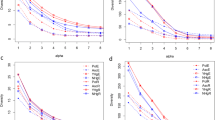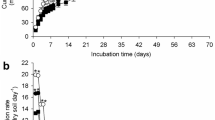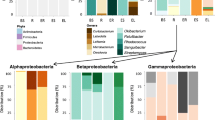Abstract
Aims
This work addresses the relevant effects that one single compound, used as model herbicide, provokes on the activity/survival of a suitable herbicide degrading model bacterium and on a plant that hosts this bacterium and its bacterial rhizospheric community.
Methods
The effects of the herbicide 2,4-dichlorophenoxyacetic acid (2,4-D), on Acacia caven hosting the 2,4-D degrading bacterium Cupriavidus pinatubonensis JMP134, and its rhizospheric microbiota, were simultaneously addressed in plant soil microcosms, and followed by culture dependent and independent procedures, herbicide removal tests, bioprotection assays and use of encapsulated bacterial cells.
Results
The herbicide provokes deleterious effects on the plant, which are significantly diminished by the presence of the plant associated C. pinatubonensis, especially with encapsulated cells. This improvement correlated with increased 2,4-D degradation rates. The herbicide significantly changes the structure of the A. caven bacterial rhizospheric community; and it also diminishes the preference of C. pinatubonensis for the A. caven rhizosphere compared with the surrounding bulk soil.
Conclusions
The addition of an herbicide to soil triggers a complex, although more or less predictable, suite of effects on rhizobacterial communities, herbicide degrading bacteria and their plant hosts that should be taken into account in fundamental studies and design of bio(phyto)remediation procedures.




Similar content being viewed by others
References
Aislabie J, Bej AK, Ryburn J, Lloyd N, Wilkins A (2005) Characterization of Arthrobacter nicotinovorans HIM, an atrazine-degrading bacterium, from agricultural soil New Zealand. FEMS Microbiol Ecol 52:279–286
Bais HP, Weir TL, Perry LG, Gilroy S, Vivanco JM (2006) The role of root exudates in rhizosphere interactions with plants and other organisms. Annu Rev Plant Biol 57:233–266
Bais HP, Broeckling CD, Vivanco JM (2008) Root exudates modulate plant—microbe interactions in the rhizosphere. In: Karlovsky P (ed) Secondary Metabolites in Soil Ecology. Soil Biology 14. Springer-Verlag, Berlin Heidelberg, pp 241–252
Barrett CF, Parker MA (2006) Coexistence of Burkholderia, Cupriavidus, and Rhizobium sp. nodule bacteria on two Mimosa spp. in Costa Rica. Appl Environ Microbiol 72:1198–1206
Bertin C, Yang X, Weston LA (2003) The role of root exudates and allelochemicals in the rhizosphere. Plant and Soil 256:67–83
Boyer JS (1982) Plant productivity and environment. Science 218:443–448
Cassidy MB, Lee H, Trevors JT (1997) Survival and activity of lac-lux marked Pseudomonas aeruginosa UG2Lr cells in encapsulated carrageenan over 4 years at 48 °C. J Microbiol Meth 30:167–170
Clement P, Pieper DH, González B (2001) Molecular characterization of a deletion/duplication rearrangement in tfd genes from Ralstonia eutropha JMP134 (pJP4) that improves growth on 3-chlorobenzoic acid but abolishes growth on 2,4-dichlorophenoxyacetic acid. Microbiology 147:2141–2148
Datsenko KA, Wanner BL (2000) One-step inactivation of chromosomal genes in Escherichia coli K-12 using PCR products. Proc Natl Acad Sci USA 97:6640–6645
de Weert S, Vermeiren H, Mulders IH, Kuiper I, Hendrickx N, Bloemberg GV, Vanderleyden J, De Mot R, Lugtenberg BJ (2002) Flagella-driven chemotaxis towards exudate components is an important trait for tomato root colonization by Pseudomonas fluorescens. Mol Plant-Microbe Interact 15:1173–1180
DiGiovanni GD, Neilson JW, Pepper IL, Sinclair NA (1996) Gene transfer of Alcaligenes eutrophus JMP134 plasmid pJP4 to indigenous recipients. Appl Environ Microbiol 62:2521–2526
Diouf D, Samba-Mbaye R, Lesueur D, Ba AT, Dreyfus B, de Lajudie P, Neyra M (2007) Genetic diversity of Acacia seyal Del. rhizobial populations indigenous to Senegalese soils in relation to salinity and pH of the sampling sites. Microb Ecol 54:553–566
Dong X, Kahmann R (2009) Battle for survival: plants and their allies and enemies. Curr Opin Plant Biol 12:387–389
Duke SO (1990) Overview of herbicide mechanisms of action. Environ Health Perspect 87:263–271
Fukumori F, Hausinger RP (1993) Purification and characterization of 2,4-dichlorophenoxyacetate/α-ketoglutarate dioxygenases. J Biol Chem 268:24311–24317
Gazitúa C, Slater AW, Melo F, González B (2010) Novel α-ketoglutarate dioxygenase tfdA related gene are found in soil DNA after exposure to phenoxyalkanoic herbicides. Environ Microbiol 12:2411–2425
Germaine KJ, Liu X, García-Cabellos GG, Hogan JP, Ryan D, Dowling DN (2006) Bacterial endophyte-enhanced phytoremediation of the organochlorine herbicide 2,4-dichlorophenoxyacetic acid. FEMS Microbiol Ecol 57:302–310
Glick BR (1995) The enhancement of plant growth by free-living bacteria. Can J Microbiol 41:109–117
Grossmann K (2000) Mode of action of auxin herbicides: a new ending to a long, drawn out story. Trends Plant Sci 5:506–508
Grossmann K (2010) Auxin herbicides: current status of mechanism and mode of action. Pest Manag Sci 66:113–120
Hoque MS, Broadhurst LM, Thrall PH (2011) Genetic characterization of root-nodule bacteria associated with Acacia salicina and A. stenophylla (Mimosaceae) across south-eastern Australia. Int J Syst Evol Microbiol 61:299–309
Jacobsen CS (1997) Plant protection and rhizosphere colonization of barley by seed inoculated herbicide degrading Burkholderia (Pseudomonas) cepacia DBO1(pRO101) in 2,4-D contaminated soil. Plant and Soil 189:139–144
Jofré E, Mori G, Castro S, Fabra A, Rivarola V, Balegno H (1996) 2,4-dichlorophenoxyacetic acid affects the attachment of Azospirillum brasilense Cd to maize roots. Toxicology 107:9–15
Kalra YP (1998) Handbook of reference methods for plant analysis. Soil and Plant Analysis Council, CRC Lewis Publ, Boca Raton
Kloepper JW, Lifshitz R, Schroth MN (1988) Pseudomonas inoculants to benefit plant production. ISI Atlas Sci Anim Plant Sci pp 60–64
Kragelund L, Nybroe O (1996) Competition between Pseudomonas fluorescens Ag1 and Alcaligenes eutrophus JMP134 (pJP4) during colonization of barley roots. FEMS Microbiol Ecol 20:41–51
Lane DJ (1991) 16S/23S rRNA sequencing. Nucleic acid techniques in bacterial systematics. Wiley, New York
Lane DJ, Pace B, Olsen GJ, Stahl DA, Sogin ML, Pace NR (1985) Rapid determination of 16S ribosomal RNA sequences for phylogenetic analyses. Proc Natl Acad Sci USA 82:6955–6959
Lazarovits G, Nowak J (1997) Rhizobacteria for improvement of plant growth and establishment. Hort Sci 32:188–192
Ledger T, Pieper DH, González B (2006) Chlorophenol hydroxylases encoded by plasmid pJP4 differentially contribute to chlorophenoxyacetic acid degradation. Appl Environ Microbiol 72:2783–2792
Ledger T, Zúñiga A, Kraiser T, Dasencich P, Donoso R, Pérez-Pantoja D, González B (2012) Aromatic compounds degradation plays a role in colonization of Arabidopsis thaliana and Acacia caven by Cupriavidus pinatubonensis JMP134. Antonie van Leeuwenhoek 101:713–723
Lindow SE, Brandl MT (2003) Microbiology of the phyllosphere. Appl Environ Microbiol 69:1875–1883
Louie TM, Webster CM, Xun L (2002) Genetic and biochemical characterization of a 2,4,6-trichlorophenol degradation pathway in Ralstonia eutropha JMP134. J Bacteriol 184:3492–3500
Lugtenberg BJ, Kravchenko LV, Simons M (1999) Tomato seed and root exudate sugars: composition, utilization by Pseudomonas biocontrol strains and role in rhizosphere colonization. Environ Microbiol 1:439–446
Lykidis A, Pérez-Pantoja D, Ledger T, Mavrommatis K, Anderson I, Ivanova N, Hooper S, Lapidus A, González B, Kyrpides N (2010) The complete multipartite genome sequence of Cupriavidus necator JMP134, a versatile pollutant degrader. PLOS One 5:e9729
Macur RE, Wheeler JT, Burr MD, Inskeep WP (2007) Impacts of 2,4-D application on soil microbial community structure and on populations associated with 2,4-D degradation. Microbiol Res 162:37–45
Manzano M, Morán AC, Tesser B, González B (2007) Role of eukaryotic microbiota in soil survival and catabolic performance of the 2,4-D herbicide degrading bacteria Cupriavidus necator JMP134. Antonie van Leeuwenhoek 91:115–126
Mastretta C, Barac T, Vangronsveld J, Newman L, van der Taghavi S, Lelie D (2006) Endophytic bacteria and their potential application to improve the phytoremediation of contaminated environments. Biotechnol Genet Engineer Rev 23:175–207
Mathysse AG, Stretton S, Dandie C, McClure NC, Goodman AE (1996) Construction of GFP vectors for use in Gram-negative bacteria other than Escherichia coli. FEMS Microbiol Lett 145:87–94
Narasimhan K, Basheer C, Bajic VB, Swarup S (2003) Enhancement of plant-microbe interactions using a rhizosphere metabolomics-driven approach and its application in the removal of polychlorinated biphenyls. Plant Phys 132:146–153
Newby DT, Gentry TJ, Pepper IL (2000) Comparison of 2,4-dichlorophenoxyacetic acid degradation and plasmid transfer in soil resulting from bioaugmentation with two different pJP4 donors. Appl Environ Microbiol 66:3399–3407
Ninomiya K, Nishioka M, Kino-oka M, Taya M (2004) Differences in responses of plant hairy roots to chemical toxicity compared between primary and ramified roots. Environ Sci 11:283–291
Ovalle C, Del Pozo A, Casado M, De Costa B, Miguel M (2006) Consequences of landscape heterogeneity on grassland diversity and productivity in the espinal agroforestry system of Central Chile. Landscape Ecol 21:585–594
Pavissich JP, Silva M, González B (2010) Sulfate reduction, molecular diversity, and copper amendment effects in bacterial communities enriched from sediments exposed to copper–mining residues. Environ Toxicol Chem 29:256–264
Pérez-Pantoja D, Ledger T, Pieper DH, González B (2003) Efficient turnover of chlorocatechols is essential for growth of Ralstonia eutropha JMP134 (pJP4) in 3-chlorobenzoic acid. J Bacteriol 185:1534–1542
Pérez-Pantoja D, De la Iglesia R, Pieper DH, González B (2008) Metabolic reconstruction of aromatic compounds degradation from the genome of the amazing pollutant-degrading bacterium Cupriavidus necator JMP134. FEMS Microbiol Rev 32:736–794
Pérez-Pantoja D, Donoso R, Junca H, González B, Pieper DH (2010) Phylogenomics of aerobic bacterial degradation of aromatics. In: Timmis KN (ed) Handbook of Hydrocarbon and Lipid Microbiology, Vol 2, Chap 39. Springer-Verlag Berlin, Germany, pp 1356–1397
Pérez-Pantoja D, Donoso R, Agulló L, Córdova M, Seeger M, Pieper DH, González B (2012) Genomic analysis of aromatic compounds biodegradation in Burkholderiales. Environ Microbiol 14:1091–1117
Shaw LJ, Burns RG (2004) Enhanced mineralisation of [U-(14C)] 2,4-dichlorophenoxyacetic acid in the soil from the rhizosphere of Trifolium pratense. Appl Environ Microbiol 70:4766–4774
Shaw LJ, Burns RG (2005) Rhizodeposition and the enhanced mineralization of 2,4-dichlorophenoxyacetic acid in soil from the Trifolium pratense rhizosphere. Environ Microbiol 7:191–202
Smit E, Wolters AC, Lee H, van Trevors JT, Elsas JD (1996) Interaction between a genetically marked Pseudomonas fluorescens strain and bacteriophage øR2f in soil: effects of nutrients, alginate encapsulation, and the wheat rhizosphere. Microb Ecol 31:125–140
Sørensen SR, Simonsen A, Aamand J (2009) Constitutive mineralization of low concentrations of the herbicide linuron by a Variovorax sp. strain. FEMS Microbiol Lett 292:291–296
Sterling TM, Hall JC (1997) Mechanism of action of natural auxins and the auxinic herbicides. In: Roe RM, Burton JD, Kuhr RJ (eds) Herbicide activity: toxicology, biochemistry and molecular biology. IOS, Amsterdam, pp 111–141
Suwa Y, Wright AD, Fukumori F, Nummy KA, Hausinger RP, Holben WE, Forney LJ (1996) Characterization of a chromosomally encoded 2,4- dichlorophenoxyacetate/ α-ketoglutarate dioxygenase from Burkholderia sp. strain RASC. Appl Environ Microbiol 62:2464–2469
Thompson IP, van der Gast CJ, Ciric L, Singer AC (2005) Bioaugmentation for bioremediation: the challenge of strain selection. Environ Microbiol 7:909–915
Top EM, Van Daele P, De Saeyer N, Forney LJ (1998) Enhancement of 2,4-dichlorophenoxyacetic acid (2,4-D) degradation in soil by dissemination of catabolic plasmids. Antonie van Leeuwenhoek 73:87–94
Trefault N, Guzmán L, Pérez H, Godoy M, González B (2009) Involvement of several transcriptional regulators in the differential expression of tfd genes in Cupriavidus necator JMP134. Int Microbiol 12:97–106
Uren NC (2007) Types, amounts, and possible functions of compounds released into the rhizosphere by soil-grown plants. In: Pinton R, Varanini Z, Nannipieri P (eds) The rhizosphere. Biochemistry and organic substances at the soil-plant interface, 2nd edn. CRC Press/Taylor & Francis Group, Boca Raton, pp 1–21
Ussery DW, Kiil K, Lagesen K, Sicheritz-Pontén T, Bohlin J, Wassenaar TM (2009) The genus Burkholderia: analysis of 56 genomic sequences. Genome Dyn 6:140–157
Van de Broek A, Lambrecht M, Vanderleyden J (1998) Bacterial chemotactic motility is important for the initiation of wheat root colonization by Azospirillum brasilense. Microbiology 144:2599–2606
van Veen JA, van Overbeek LS, van Elsas JD (1997) Fate and activity of microorganisms introduced into soil. Microbiol Mol Biol Rev 61:121–135
Weir SC, Dupuis SP, Providenti MA, Lee H, Trevors JT (1995) Nutrient enhanced survival of and phenanthrene mineralization by alginate encapsulated and free Pseudomonas sp. UG14Lr cells in creosote contaminated soil slurries. Appl Microbiol Biotechnol 43:946–951
Young CC, Rekha PD, Lai WA, Arun AB (2006) Encapsulation of plant growth-promoting bacteria in alginate beads enriched with humic acid. Biotechnol Bioeng 95:76–86
Zhang J, Zheng JW, Liang B, Wang CH, Cai S, Ni YY, He J, Li SP (2011) Biodegradation of chloroacetamide herbicides by Paracoccus sp. FLY-8 in vitro. J Agric Food Chem 59:4614–4621
Zheng H, Hall C (2001) Understanding auxinic herbicide resistance in wild mustard: physiology, biochemical, and molecular genetic approaches. Weed Sci 49:276–281
Acknowledgments
This work has been funded by the Fondo de Desarrollo de la Ciencia y la Tecnología (FONDECYT) grants 1070343 and 3090051, and the Millennium Nuclei in “Microbial Ecology and Environmental Microbiology and Biotechnology” grant P/04-007-F, and “Plant Functional Genomics” grant P/06-009-F. This study is also part of the research program Fondo de Desarrollo de Áreas Prioritarias (FONDAP) 1501–0001 funded by Comisión Nacional de Investigación Científica y Tecnologíca (CONICYT) to the Center for Advanced Studies in Ecology & Biodiversity Program 7. T.K. is CONICYT- PhD fellow. M.S. and T.L. are postdoctoral fellows of Programa de Atracción e Inserción de Capital Humano Avanzado, PAI/AC 79090016.
Author information
Authors and Affiliations
Corresponding author
Additional information
Responsible Editor: Hans Lambers.
Rights and permissions
About this article
Cite this article
Kraiser, T., Stuardo, M., Manzano, M. et al. Simultaneous assessment of the effects of an herbicide on the triad: rhizobacterial community, an herbicide degrading soil bacterium and their plant host. Plant Soil 366, 377–388 (2013). https://doi.org/10.1007/s11104-012-1444-8
Received:
Accepted:
Published:
Issue Date:
DOI: https://doi.org/10.1007/s11104-012-1444-8




